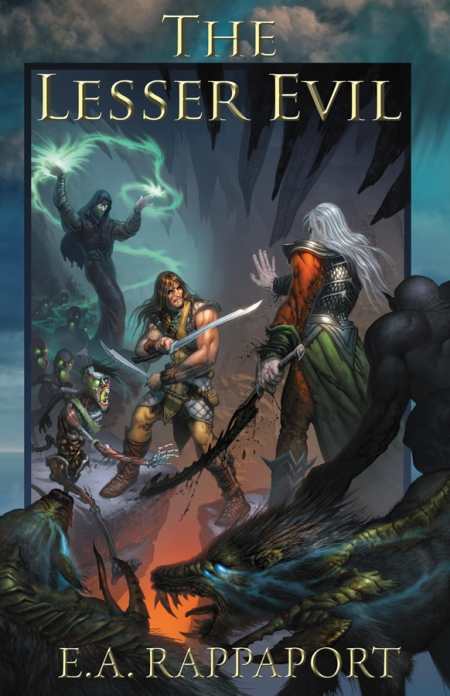The Lesser Evil
- 2012 INDIES Finalist
- Finalist, Fantasy (Adult Fiction)
As E. A. Rappaport’s The Lesser Evil opens, Toth, a talented young wizard, seeks to persuade the stodgy Wizard’s Council to recognize his new discovery—a method of animating dead skeletons—as a valid new “school” of magic. Soon, he’s exiled to pursue his obsession alone. Elsewhere, Senfra, a ruthless bandit who thinks of himself as the champion of downtrodden peasants, also falls on hard times.
In the confused aftermath of a disastrous war, innocent people begin disappearing, unnatural creatures are seen, and unlikely companions Toth and Senfra may be forced to join forces against an unprecedented evil.
According to the title page, The Lesser Evil is the fifth book in Rappaport’s Legends of the Four Races, the second book in his Transmuter Trilogy, and the second book in his War Trilogy. The author’s website clarifies that The Lesser Evil it is part of an interlocking matrix of nine books, which are displayed on the site in a three-by-three grid.
This is an interesting strategy for portraying a complex set of interwoven plots; however, it has shortcomings for readers who approach any one volume as a stand-alone story. Several key events in the plot—including a cataclysmic war and the dissolution of the Wizard’s Council, whose debates make up the first chapter—take place offstage and are not described, presumably because they have been described in previous volumes. Although Rappaport tells enough about these events to ensure that the attentive reader is aware of them, his strategy is somewhat disorienting.
Rappaport has a competent and engaging prose style and keeps the plot moving energetically. The characters are a bit simplistic, and many of them are recognizably based on popular fantasy-adventure stereotypes—the fighter, the wizard, nonhuman races resembling elves and dwarves, among others—but they rarely stand still long enough for this to be a problem. The novel is most unpredictable and creative when it ventures into territory that fantasy novels rarely explore in detail, such as the young necromancer Toth’s surreptitious attempts to acquire fresh bones to experiment with, the dubious reactions he gets from the living, and the sometimes dangerous results he obtains.
The only obvious flaw in Rappaport’s dialogue is a tendency for characters engaged in life-or-death combat to have somewhat stilted blow-by-blow conversations with their opponents. The characters of The Lesser Evil display neither the poetic whimsy of Cyrano de Bergerac nor the pithy silence in which Conan the Cimmerian prefers to decapitate his foes.
The Lesser Evil brings some interesting changes to familiar tropes of fantasy fiction, most notably by making a necromancer and a pirate, each typically portrayed as a villain, into sympathetic protagonists. The book is likely to appeal to fans of fantasy role-playing games and readers of fantasy fiction.
Reviewed by
Bradley A. Scott
Disclosure: This article is not an endorsement, but a review. The publisher of this book provided free copies of the book and paid a small fee to have their book reviewed by a professional reviewer. Foreword Reviews and Clarion Reviews make no guarantee that the publisher will receive a positive review. Foreword Magazine, Inc. is disclosing this in accordance with the Federal Trade Commission’s 16 CFR, Part 255.

